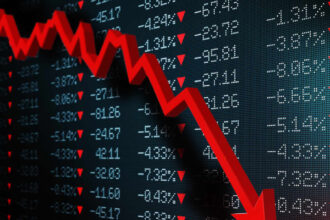Bed Bath & Beyond is desperately seeking to avoid bankruptcy, and its bonds were battered in a turbulent month.
Kena Betancur/VIEWpress/Getty Images
March madness in 2023 might better refer to the crazy action of the financial markets than to some overhyped basketball tournament.
Over the course of the month just ended, expectations about the economy and Federal Reserve policy swung from one extreme to another. Early on, Fed officials were talking up more and bigger interest-rate increases to slow stubborn inflation. Then, seemingly out of nowhere, came the second-largest bank failure in U.S. history. Suddenly, we seemed headed into the abyss of recession.
But federal bank regulators stitched together a new safety net, and by month’s end, the bank runs apparently had slowed to a stroll. Nonetheless, despite a marked absence of evidence of significant economic weakening, fears that banks had lost deposits—or at least might have to start paying up for them—and would clamp down on credit put everyone on recession watch again.
In financial markets, cognitive dissonance took over. Expectations switched to falling interest rates; the Fed was seen ending its increases by May and reversing course in the year’s second half. Bond prices rallied, with yields falling.
Stocks reacted positively to the prospect of future Fed easing. Technology led the advance, with the
Nasdaq Composite
ending up 6.69% in March and 16.77% in the quarter, its best showing since 2020’s second three months. The broader large-cap market was up 3.51% for the month and 7.03% for the quarter, as measured by the
S&P 500
index. While those gains followed double-digit losses in 2022, they hardly seem like harbingers of recession.
Whether the expectations of lower interest rates are bearish or bullish depends on what the failures of Silicon Valley Bank and Signature Bank signify. If they are analogous to the Bear Stearns collapse in March 2008, look for new lows, according to Bank of America’s strategy team, led by Michael Hartnett. However, if they resemble the meltdown of the Long-Term Capital Management hedge fund in the fall of 1998, expect new highs, similar to those that followed the subsequent Fed easing and dot-com meltup.
The expectations of lower rates are embodied in the negatively sloped yield curve—the graph of Treasury yields—with shorter maturities now paying more than longer ones. That classically has portended recession, as investors anticipate future rate cuts.
As tracked by the spread between the two- and 10-year Treasury notes, which respectively yielded 4.044% and 3.479% on Friday, the curve is inverted by 56.3 basis points. (A basis point is 1/100th of a percentage point.) The yield curve actually has become less inverted since March 8, when the spread was negative 107 basis points, according to the St. Louis Fed. That mainly reflected a stunning drop in the two-year yield, from a peak of 5.05% at the market close on March 8 in the wake of the bank worries.
But the message of the inverted yield curve may be muddled by the Fed’s policy. According to a post on the blog of former AllianceBernstein chief economist Joseph Carson, the Fed’s large portfolio of $7.9 trillion of Treasury and agency mortgage securities, while $1 trillion lower than its peak a year ago, still exerts downward pressure on longer-term yields. That would tend to push longer yields below the inflation rate. This condition, of negative real yields, implies that the central bank might have to raise its short-term federal-funds rate target further to suppress inflation, he writes.
The current target range of 4.75% to 5% is barely positive in real terms, based on the Fed’s preferred inflation measure, the “core” (ex-food and energy) personal consumption deflator, which is up 4.6% over the past 12 months and 4.9% annualized in the latest three months, according to Brean Capital economists John Ryding and Conrad DeQuadros. And further stripping out housing costs, which Fed Chairman Jerome Powell has said he prefers, those rates are 4.6% and 4.8%, respectively, still more than double the central bank’s target of 2%.
Whether the Fed raises rates by another 25 basis points or stands pat at its next policy meeting on May 2-3 was a virtual coin toss by week’s end, according to the CME FedWatch site.
The odds are likely to be tipped by the March employment data, slated for release on Friday, which is expected to show another sturdy rise of 225,000 in nonfarm payrolls, an unchanged jobless rate of 3.6%, and a 0.3% rise in average hourly earnings.
Given the month just ended, more madness may follow the jobs numbers.
Write to Randall W. Forsyth at [email protected]
Read the full article here










